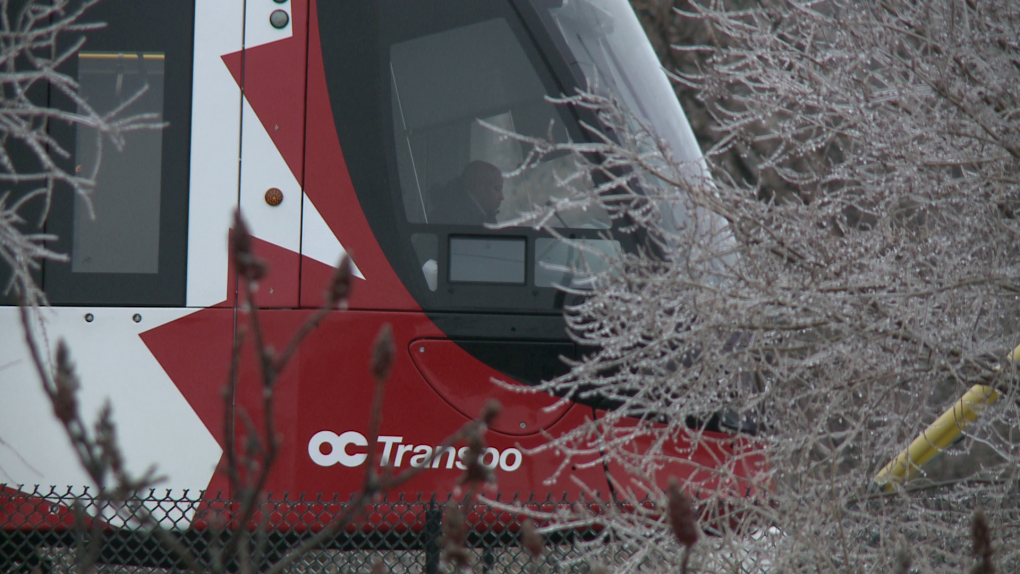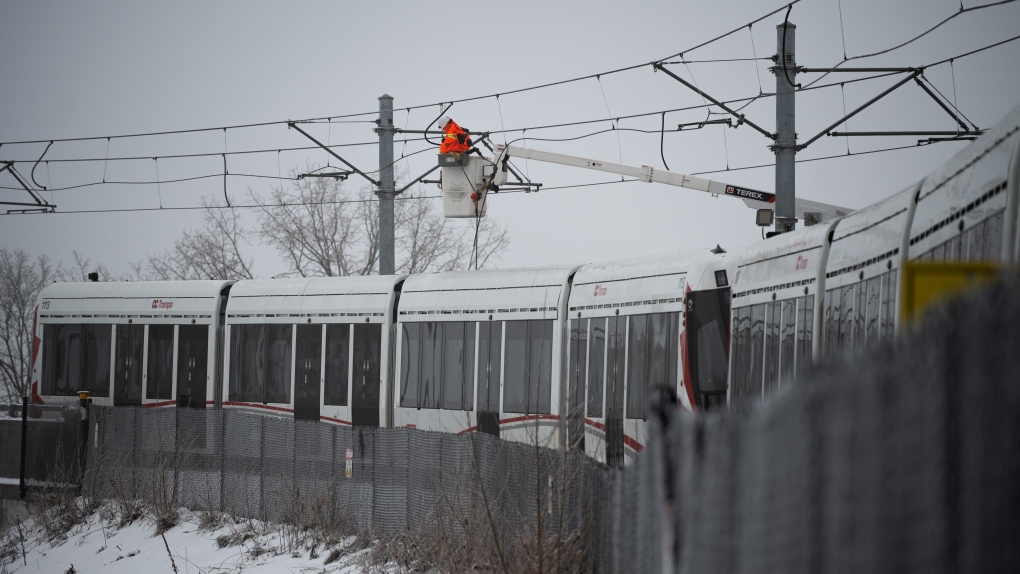Officials blame Ottawa LRT shutdown on 'unique' ice buildup
More than a month since a section of Ottawa’s LRT system shut down for six days after a freezing rainstorm, officials have revealed the cause of the outage.
The short answer: it was ice.
But how the ice got there, officials said, was due to a “unique combination of factors.”
Those factors led to two trains on the Confederation Line, one eastbound and one westbound, getting stuck near Hurdman Station. Two trains later sent to help also got stuck.
The city and its LRT contractor Rideau Transit Maintenance said they are exploring several options—from anti-icing treatments to a rescue diesel train—to stop a similar outage from happening again.
It is not clear why, after four years of operating the system, some of the ice mitigation strategies have not been put in place.
‘Unique’ weather conditions
The city’s transit commission heard details for the first time on Thursday about what exactly led to the shutdown in early January.
The six-day shutdown happened when some freezing rain caused buildup on the overhead wire that powers the trains between Hurdman and Lees stations. Service still ran on parts of the line farther east and west.
 A stopped LRT train just east of Hurdman Station on Thursday, Jan. 5, 2023. (Jim O'Grady/CTV News Ottawa)
A stopped LRT train just east of Hurdman Station on Thursday, Jan. 5, 2023. (Jim O'Grady/CTV News Ottawa)
Richard Holder, the city’s director of engineering, said specific conditions at the time led to more ice buildup on the wires than usual.
The Rideau River was ice-free due to a warmer-than-usual start to January, he said. That led to high levels of humidity in the area, which led to further accumulation on top of the freezing rain. This all led to ice quickly building up on the overhead catenary wire that powers the trains, he said.
“This unique combination of factors caused greater ice building in that area than elsewhere on the system,” Holder said. “We’re very certain that this occurred because of the accumulated ice on the OCS contact wire.”
Contact wire ‘melted’
When recovery trains were dispatched later, they were forced to go slowly, which resulted in a lot of electrical arcing on a small section of the contact wire.
“Normally when a vehicle is moving fast and you get arcing, the arcing event is spread out over a larger area, with the vehicles basically stationary that arcing all occurred in the same section, creating a huge amount of energy, a huge amount of heat generated,” he said.
“The contact wires basically melted,” Holder said.
Crews then had to spent several days clearing ice off the wires and then fixing the wires. They broke ice by hand off about 5.6 kilometres of the line, from uOttawa station all the way to Tremblay station.
 A worker repairs overhead wires on a stalled LRT OC Transpo train near Lees Ave., station in Ottawa, on Friday, Jan. 6, 2023. According to city officials freezing rain partially shut down train service between a number of station in the city’s east-end damaging overhead wires. (Spencer Colby/THE CANADIAN PRESS)
A worker repairs overhead wires on a stalled LRT OC Transpo train near Lees Ave., station in Ottawa, on Friday, Jan. 6, 2023. According to city officials freezing rain partially shut down train service between a number of station in the city’s east-end damaging overhead wires. (Spencer Colby/THE CANADIAN PRESS)
“That breaking of the ice, and when I say by hand, it is literally somebody in a high-rail vehicle on a bucket breaking the ice off by hand,” he said.
And while repairing the wires only took a few hours, he said a full inspection of the system took several days.
City looking into diesel rescue train
The city and Rideau Transit Maintenance have established a working group on the overhead wires.
Certain changes have already been made. The city is installing winter carbons on light rail vehicles, Holder said.
“Those are a brass insert installed into the pantograph, which have a more aggressive metal edge and are able to break through and shear off the ice accumulation,” he said.
OC Transpo will also “strategically” place staff on the line for monitoring ice buildup and arcing, he said. And a new onboard train diagnostic system will give advance warning for issues happening with the vehicle, such as voltage drops.
Down the line, the city is also investigating use of anti-icing treatments to be used on the contact wires in advance of freezing rain, Holder said. The Toronto Transit Commission uses such a system.
“They have a pretty extensive program for their trams where they have vehicles out on the street continually spraying anti-freezing agents onto the OCS,” he said.
They are also looking at procuring a diesel recovery train, which wouldn’t be affected by problems with the overhead wire.
“I’m kind of shocked we don’t have one of those yet,” Coun. Tim Tierney told transit commission.
RTM head Mario Guerra said they are already looking for such a vehicle.
“You can appreciate our system is unique in terms of the envelope, so it’s going to prove difficult to get something off the shelf that would fit into our system,” he said. “But we also have some equipment here that we think we might be able to alter for that purpose.”
CTVNews.ca Top Stories

Wrongfully convicted N.B. man has mixed feelings since exoneration
Robert Mailman, 76, was exonerated on Jan. 4 of a 1983 murder for which he and his friend Walter Gillespie served lengthy prison terms.
Can the Governor General do what Pierre Poilievre is asking? This expert says no
A historically difficult week for Prime Minister Justin Trudeau and his Liberal government ended with a renewed push from Conservative Leader Pierre Poilievre to topple this government – this time in the form a letter to the Governor General.
opinion Christmas movies for people who don't like Christmas movies
The holidays can bring up a whole gamut of emotions, not just love and goodwill. So CTV film critic Richard Crouse offers up a list of Christmas movies for people who might not enjoy traditional Christmas movies.
'I'm still thinking pinch me': lost puppy reunited with family after five years
After almost five years of searching and never giving up hope, the Tuffin family received the best Christmas gift they could have hoped for: being reunited with their long-lost puppy.
Pickup truck driver killed by police after driving through Texas mall and injuring 5
A pickup truck driver fleeing police careened through the doors of a JCPenney store in Texas and continued through a busy mall, injuring five people before he was fatally shot by officers, authorities said.
Two U.S. Navy pilots shot down over Red Sea in apparent 'friendly fire' incident, U.S. military says
Two U.S. Navy pilots were shot down Sunday over the Red Sea in an apparent 'friendly fire' incident, the U.S military said, marking the most serious incident to threaten troops in over a year of America targeting Yemen's Houthi rebels.
Big splash: Halifax mermaid waves goodbye after 16 years
Halifax's Raina the Mermaid is closing her business after 16 years in the Maritimes.
6 adults, 4 children taken to hospital following suspected carbon monoxide exposure in Vanier
The Ottawa Police Service says ten people were taken to hospital, with one of them in life-threatening condition, after being exposed to suspected carbon monoxide in the neighbourhood of Vanier on Sunday morning.
'Sonic 3' bests 'Mufasa: The Lion King' at the box office
In the holiday season battle of big-budget family movies, Paramount Pictures’ “Sonic the Hedgehog 3” sped past the Walt Disney Co.’s “Mufasa: The Lion King” to take the top spot at the box office ahead of the lucrative Christmas corridor in theaters.


































